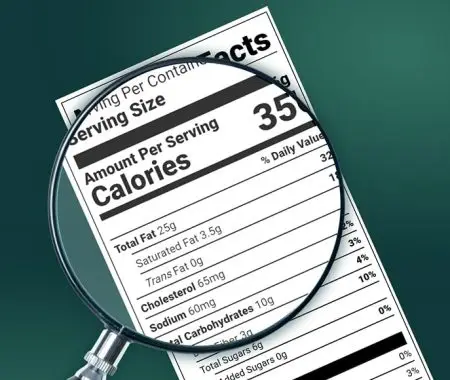Navigating the intricate world of food labeling and the regulatory requirements that come with it can be a challenging task. With various claims that can be made about a product’s health benefits and nutritional content, it’s essential to understand the differences and implications of each. One of the most common dilemmas faced by producers is understanding the distinction between a health claim vs structure function claim. Delving deeper, there are three primary types of health claims you’ll encounter:
- Health Claims, which describe a food’s potential health benefits.
- Nutrient Content Claims, highlighting the level of specific nutrients in a product.
- Structure/Function Claims, which explain a nutrient or ingredient’s role in the body’s structure or function.
This article will provide an in-depth exploration of these claims, ensuring clarity and compliance in your food labeling endeavors. By the end, you’ll have a clearer understanding of each, ensuring that your product’s label is both compliant and informative.
Summary Table:
| Claim Type | Description | Example | What It Is Not | Requirements |
| Health Claim | Describes the relationship between a food product and a reduced risk of a disease or health-related condition. | “Diets low in sodium may reduce the risk of high blood pressure.” | “Eating a balanced diet is important for overall well-being.” | Must be complete, truthful, and not misleading.Cannot be about the diagnosis, cure, mitigation, or treatment of diseases.Certain foods may be disqualified based on nutrient levels.The substance must have a taste, aroma, or nutrient value at the levels used. |
| Nutrient Content Claim | Characterizes the level of a specific nutrient in a food product. | “High in Vitamin C” | “Good for your health” | Must accurately represent the nutrient level.Should not be misleading.Must meet the FDA’s criteria for the specific claim. |
| Structure/Function Claim | Describes the role of a nutrient or ingredient concerning the structure or function of the human body. | “Calcium builds strong bones.” | “May reduce the risk of heart disease” | Should accurately represent the role of the nutrient or ingredient.Should not be misleading.Conventional food producers don’t need to notify the FDA or make disclaimers. |
In the landscape of food labeling, it’s crucial to discern between different types of claims. Health claims specifically highlight the relationship between a food product and its potential to reduce the risk of a disease or health condition. On the other hand, structure/function claims emphasize how a nutrient or ingredient affects the body’s structure or function. For instance, while a health claim might suggest that low sodium diets can mitigate high blood pressure risks, a structure/function claim would underscore that calcium is instrumental in building strong bones.
Health Claims
Health claims are pivotal in food labeling as they describe the relationship between a food product and a reduced risk of a disease or a health-related condition. These claims can be made using words, images, or even references to third-party certifications.
Examples:
- “Diets low in sodium may reduce the risk of high blood pressure.”
- “Intake of calcium may support bone health.”
What it is not:
It’s essential to differentiate between health claims and general statements. For instance, “Eating a balanced diet is important for overall well-being” is not a health claim. Such statements are more about dietary guidance and don’t assert a reduced risk of a specific disease or health condition.
Types:
- Authorized Health Claims: These claims have been reviewed and approved by the FDA based on “significant scientific agreement.”
- Qualified Health Claims: These are claims supported by scientific evidence but don’t meet the “significant scientific agreement” standard. The FDA authorizes them with specific wording guidelines.
Requirements:
- Health claims must be complete, truthful, and not misleading.
- They cannot be about the diagnosis, cure, mitigation, or treatment of diseases.
- Certain foods may be disqualified from health claims based on nutrient levels deemed unhealthy.
- The substance that is the subject of the health claim must have a taste, aroma, or nutrient value when consumed at the levels used to justify the claim.
Authorized Health Claims
Authorized Health Claims describe a health claim that has been reviewed by the FDA and approved for use. There must be a robust scientific case for the FDA to issue an Authorized Health Claim. For instance, the claim “Eating soluble fiber from foods such as oatmeal, as part of a diet low in saturated fat and cholesterol, may reduce the risk of heart disease” is an example of an authorized health claim.
Qualified Health Claim
A Qualified Health Claim is a statement approved by the FDA for use on food labels that has strict wording requirements. When there’s emerging evidence between a food and the reduced risk of a disease or health condition, but not enough for the FDA to issue an Authorized Health Claim, the FDA may approve a “Qualified Health Claim”.
An example might be: “Some scientific evidence suggests that consumption of antioxidant vitamins may reduce the risk of certain forms of cancer.” However, the FDA has determined that this evidence is limited and not conclusive.
See How FoodLabelMaker Can Help You
Nutrient Content Claims
Nutrient content claims characterize the level of a specific nutrient in a food product. These claims are different from the information listed in the Nutrition Information Panel. Any claims made about nutrition outside of this panel are considered nutrient content claims.
Examples:
- “High in Vitamin C”
- “Low Fat”
- “Reduced Sodium”
What it is not:
It’s crucial to distinguish nutrient content claims from general health statements. For instance, “Good for your health” is not a nutrient content claim. Such statements are more general and don’t specify the nutrient level in the product.
Types:
- Absolute Claims: These claims describe a product’s nutrient level without comparing it to another product, e.g., “High Fiber.”
- Comparative Claims: These claims compare the nutrient levels of two or more products, e.g., “Reduced Fat compared to regular chips.”
Requirements:
- The claim must accurately represent the nutrient level in the product.
- It should not be misleading to consumers.
- The nutrient level should meet the FDA’s defined criteria for the specific claim being made.
Structure/Function Claims
Structure/function claims describe the role of a nutrient or ingredient concerning the structure or function of the human body. These claims can appear on the labels of foods, dietary supplements, or even drugs.
Examples:
- “Calcium builds strong bones.”
- “Fiber maintains bowel regularity.”
- “Antioxidants maintain cell integrity.”
What it is not:
It’s essential to differentiate structure/function claims from disease claims. For instance, “May reduce the risk of heart disease” outlines the difference between a health claim vs structure function claim.
Types:
- Claims of General Well-Being: These describe general well-being from consumption of a nutrient or ingredient.
- Nutrient-Deficiency Disease Claims: These describe a benefit related to a nutrient deficiency disease (such as vitamin C and scurvy).
Categories:
- General Well-Being Claims: Describe general well-being from consumption of a nutrient or ingredient.
- Nutrient-Deficiency Disease Claims: Describe a benefit related to a nutrient deficiency disease.
Requirements:
- The claim should accurately represent the role of the nutrient or ingredient.
- It should not be misleading to consumers.
- Conventional food producers do not need to notify the FDA about structure/function claims or make disclaimers associated with these claims on their product labels. However, producers of Dietary Supplements may face additional requirements.
Click here for a more in-depth guide on health claims according to the FDA Food Labeling Guide.



